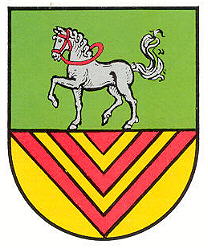Winzeln (Pirmasens): Difference between revisions
Jump to navigation
Jump to search
Knorrepoes (talk | contribs) m (Text replacement - "/Arms of " to "/Arms (crest) of ") |
Knorrepoes (talk | contribs) m (Text replacement - "{{media}}" to " {{de1}} {{media1}}") |
||
| Line 24: | Line 24: | ||
The lower half The small shield shows the arms of the Lords of <a href=h/hanau|Hanau]]-Lichtenberg, to which the village historically belonged. The upper half shows a horse, symbolizing the long tradition of horse-breeding and horse-racing in the village. The green colour of the field is taken from the name of the village, which is derived from Winede, or place with meadows. | The lower half The small shield shows the arms of the Lords of <a href=h/hanau|Hanau]]-Lichtenberg, to which the village historically belonged. The upper half shows a horse, symbolizing the long tradition of horse-breeding and horse-racing in the village. The green colour of the field is taken from the name of the village, which is derived from Winede, or place with meadows. | ||
{{ | |||
{{de1}} | |||
{{media1}} | |||
[[Civic Heraldry Literature - Germany|'''Literature''']]: Debus, 1988. | [[Civic Heraldry Literature - Germany|'''Literature''']]: Debus, 1988. | ||
Revision as of 11:08, 26 December 2022
This page is part of the German heraldry portal Deutsche Wappensammlung |
Heraldry of the World |
|
German heraldry:
|
Selected collector's items from Germany:
|
WINZELN
State : Rheinland-Pfalz
Urban district (Stadtkreis) : Pirmasens
Incorporated into : 1969 Pirmasens
| German | |
| English | (Pirmasens) No blazon/translation known. Please click here to send your (heraldic !) blazon or translation |
Origin/meaning
The arms were granted on March 17, 1955.
The lower half The small shield shows the arms of the Lords of <a href=h/hanau|Hanau]]-Lichtenberg, to which the village historically belonged. The upper half shows a horse, symbolizing the long tradition of horse-breeding and horse-racing in the village. The green colour of the field is taken from the name of the village, which is derived from Winede, or place with meadows.
Literature: Debus, 1988.


